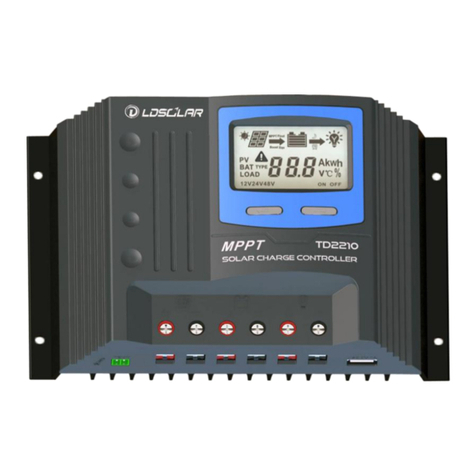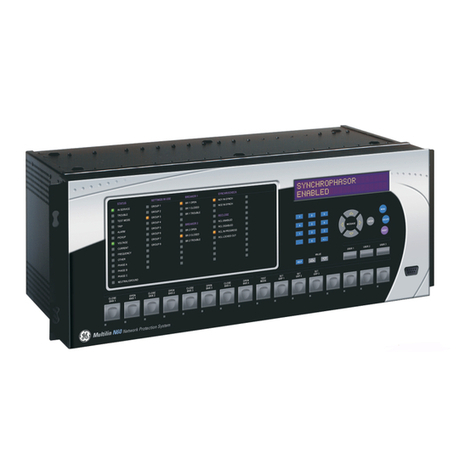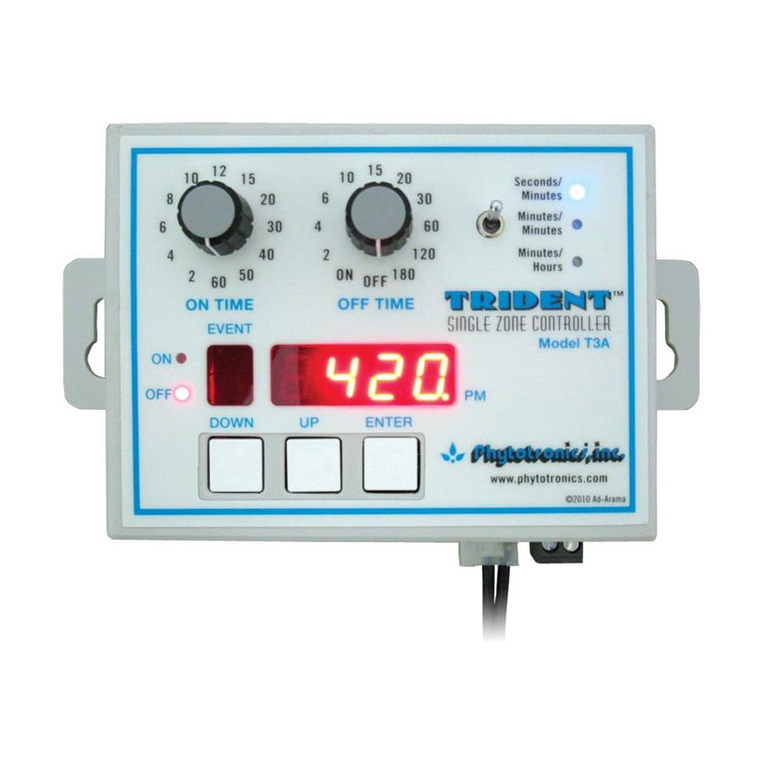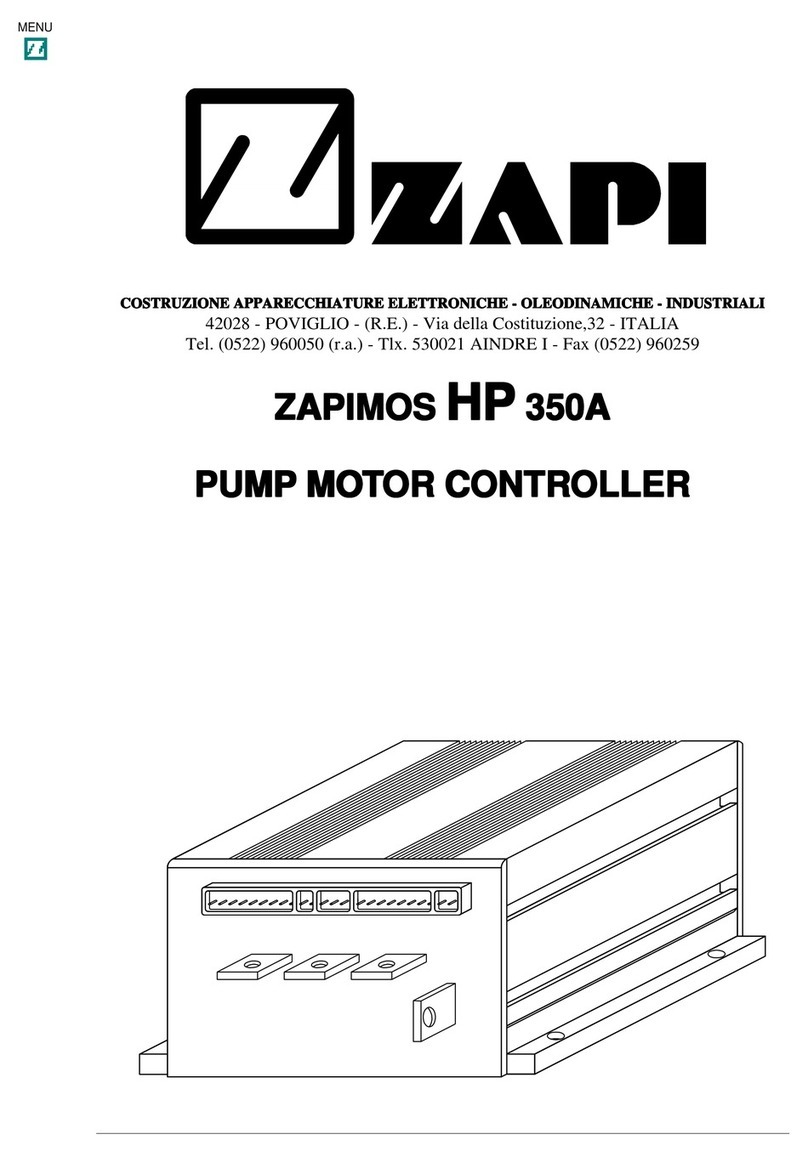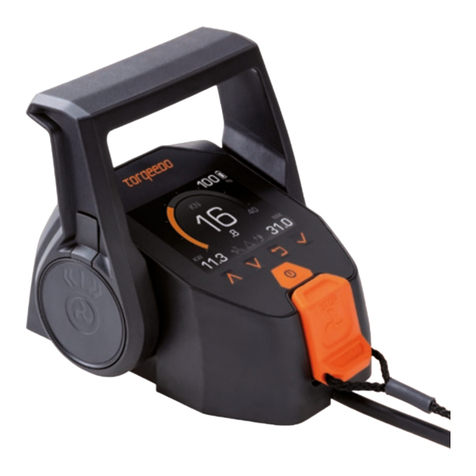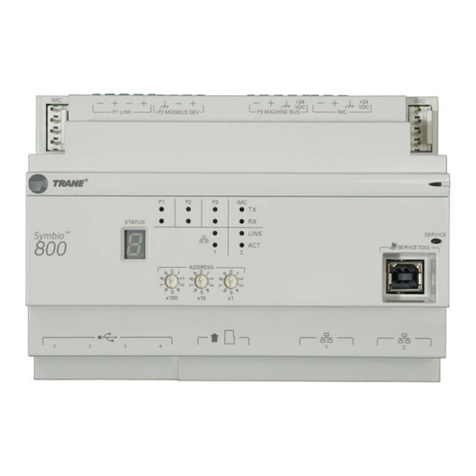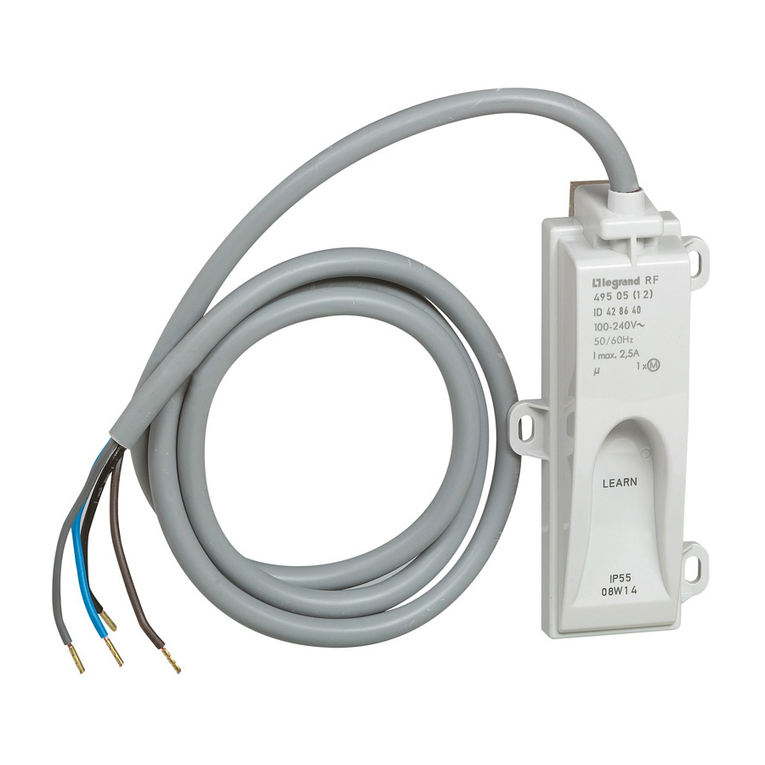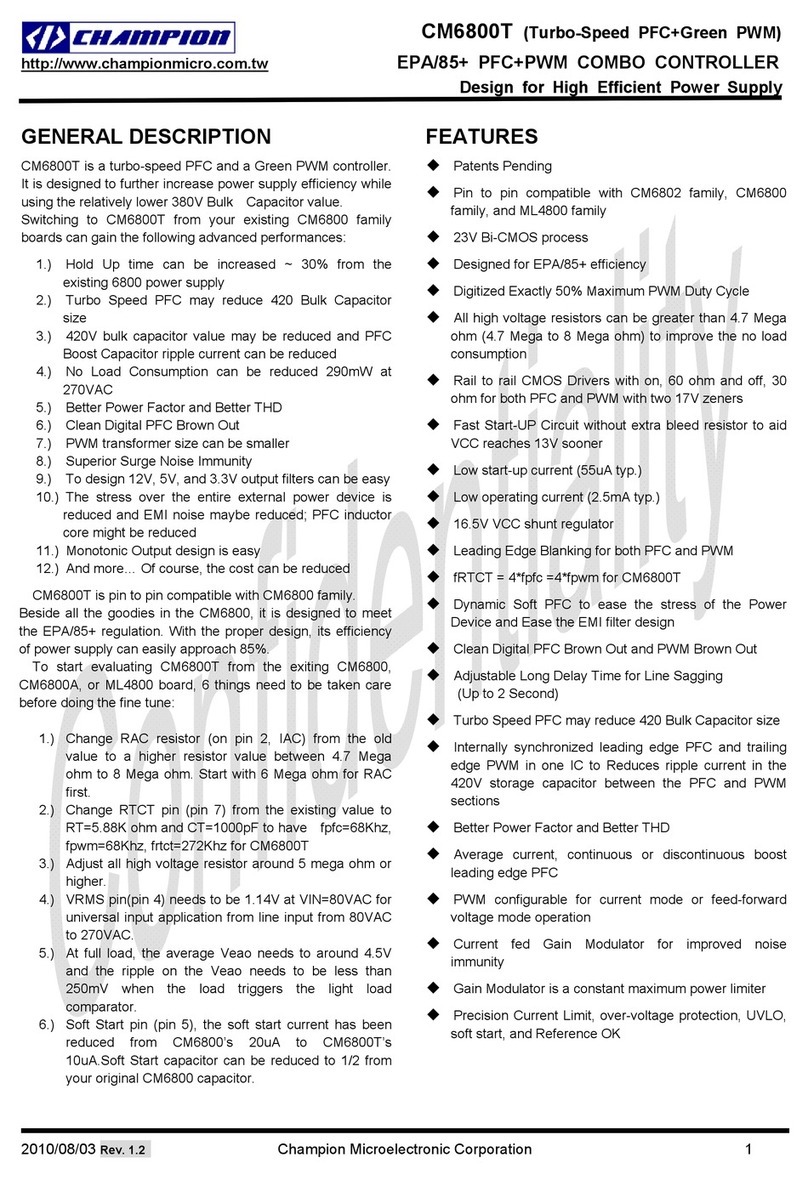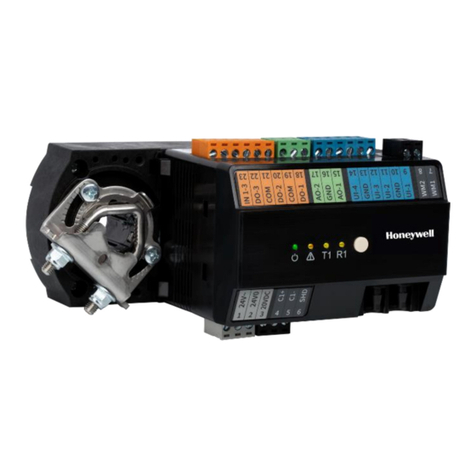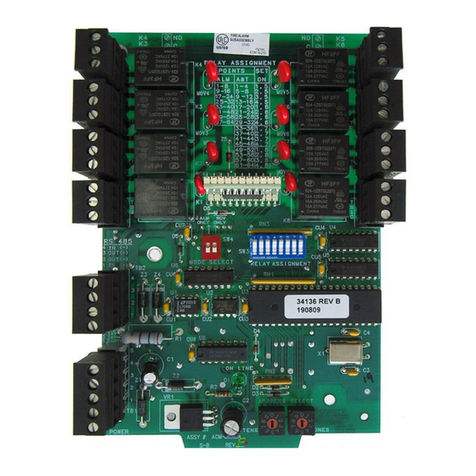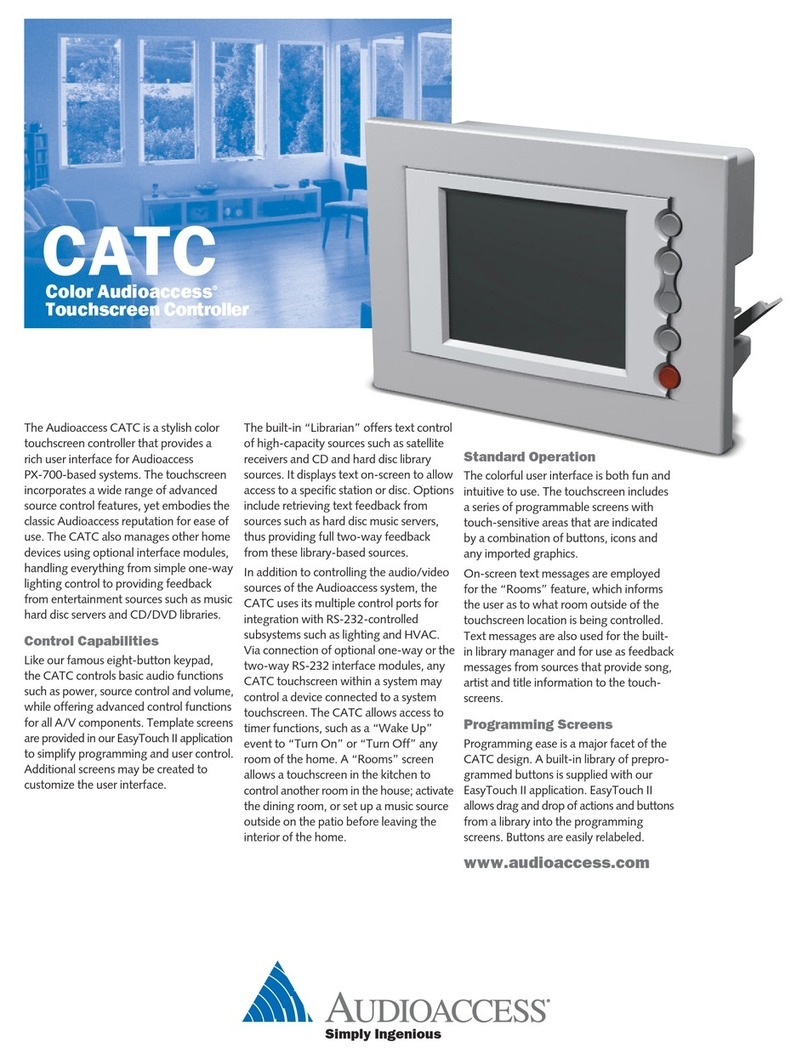Ldsolar TD4620Pro User manual

2

1
Dear users,
Thank you for choosing our product !
Important Safety Instructions
Please keep this manual for future review.
This manual contains all instructions of safety, installation and operation for Tracer Dream 200V series
Maximum Power Point Tracking (MPPT) controller ("the controller" as referred to in this manual).
General Safety Information
①Read carefully all the instructions and warnings in the manual before installation.
②No user serviceable components inside the controller. Don’t disassemble or attempt to repair the
controller.
③Mount the controller indoors. Avoid exposure the components and do not allow water to enter the
controller.
④Install the controller in a well ventilated place. The controller's heat sink may become very hot during
operation.
⑤Suggest installing appropriate external fuses/breakers.
⑥Make sure to switch off all PV array connections and the battery fuse or breakers before controller
installation and adjustment.
⑦Power connections must remain tight to avoid excessive heating from loose connection.
Explanation of symbols
•Toenable users to use the product efficiently and ensure personal and property safety,
please read related literature accompanying the followingsymbols.
•Please read the literature accompanying the following symbols.
Tips: Indicate recommendations that can be referred to.
IMPORTANT: Indicates a critical tip during the operation, if ignored, may cause the
device to run in error.
CAUTION: Indicates potential hazards, if not avoided, may cause the device
damaged.
WARNING: Indicates the danger of electric shock; if not avoided, it would cause
casualties.
1. General Information
1.1 Overview
Tracer Dream 200V Series controller is based on Multi phase synchronous rectification technology and
advanced MPPT control algorithm, adopt co-negative design, with LCD displaying running status. The MPPT
control algorithm can minimize the maximum power point loss rate and loss time, quickly track the maximum
power point of the PV array and obtain the maximum energy from solar modules under any conditions; and
can increase the ratio of energy utilization in the solar system by 20%-30% compared with a PWM charging
method.
The Tracer Dream 200V Series controller owns a self-adaptive three-stage charging mode based on a digital
control circuit. This function can effectively prolong the battery's lifespan and significantly improve the system's
performance.
Limiting the charging power and reducing charging power functions ensure the system stable with over PV
modules in high temperature environment.
With comprehensive electronic fault self-detecting functions and powerful electronic protection functions built
inside the controller, component damage caused by installation errors or system failures can be avoided to the
greatest extent possible.

2
The utility/generator dry contact to connect external devices conveniently composes a hybrid
power system easily.
The isolated RS485 port with standard MODBUS communication protocol and 5V power supply is easy to
expand the application and connect the external Bluetooth/WiFi module. The controller can be widely used for
various applications, e.g., solar RV, household system and field monitoring, etc.
Features:
◼With the advanced dual-peak or multi-peak tracking technology, when the solar panel is shadowed or part
of the panel fails resulting in multiple peaks on the I-V curve, the controller is still able to accurately track
the maximum power point.
◼Advanced MPPT technology, with efficiency no less than 99.5%
◼Maximum DC/DC conversion efficiency of 98%
◼Ultra-fast tracking speed and guaranteed tracking efficiency
◼Advanced MPPT control algorithm to minimize the MPP loss rate and loss time
◼Wide MPP operating voltage range
◼Limit charging power & current over rated range.When the solar panel power exceeds a certain level and
the charging current is larger than the rated current, the controller will automatically lower the charging
power and bring the charging current to the rated level.
◼Support the lead-acid,gel,flooded with the needed Temp. compensation and support lithium batteries
starting from solar panel
◼Real-time working record function
◼Load dry contact to control the external loadswitch
◼Auto-control of utility and generator dry contact design to compose a hybrid power system easily
◼Power reduction automatically over temperature range
◼TVS lighting protection.
◼Support parameters setting via the iConnect App
1.2 Characteristics
①Ldsolar logo
②LCD with backlight
③Menu
④up
⑤Down
⑥OK
⑦Return
⑧Battery Terminals⑴
⑨Solar Panel Terminals⑴
⑩Screw Hole(M3)
⑪Mounting Hole
⑫Diesel Generator Relay
⑬(Load) Dry Contact OFF
⑭(Load) Dry Contact ON
⑮RBVS interface(2)
⑯RTS interface(3)
⑰RJ45 Port(5VDC/200mA)(4)
Figure 1-1 Product Characteristics

3
(1) The controller is designed with a common negative polarity. The negative polarity of the PV and the battery is
located on the same busbar.
(2) Connect an RBVS (Remote Battery Voltage Sensor) to detect accurate battery voltage. The sampling distance
is no longer than 20m.
(3) Connect an RTS (Remote Temperature Sensor) to remotely detect the battery temperature. The sampling
distance is no longer than20m.
★If the temperature sensor is short-circuited or damaged, the controller will charge at the default temperature setting
of 25℃.(no temperature compensation)
(4) When connecting the controller to external devices,only one of the RJ45 port can be used.when connecting
multiple controller in parallel,RJ45 port are for cascade use.
1.3 Naming Rules of Controller models
Figure 1-2 Example
1.4 Maximum Power Point Tracking Technology
Due to the nonlinear characteristics of solar array, there is a maximum energy output point (Max Power Point)
on its curve. Traditional controllers, with switch charging technology and PWM charging technology, can't
charge the battery at the maximum power point, so can't harvest the maximum energy available fromPV array,
but the solar charge controller with Maximum
Power Point Tracking (MPPT) Technology can lock on the point to harvest the maximum energy and deliver it
to the battery.
The MPPT algorithm of our company continuously compares and adjusts the operating points to attempt to
locate the maximum power point of the array. The tracking process is fully automatic and does not need user
adjustment.
As the Figure 1-2, the curve is also the characteristic curve of the array, the MPPT technology will ‘boost' the
battery charge current through tracking the MPP. Assuming 100% conversion efficiency of the solar system, in
that way, the following formula is established:

4
Normally, the VMpp is always higher than VBat, Due to the principle of conservation of energy, the IBat is always
higher than IPV. The greater the discrepancy between VMpp &VBat, the greater the discrepancy between IPV& IBat.
The greater the discrepancy between array and battery, the bigger reduction of the conversion efficiency of the
system, thus the controller's conversion efficiency is particularly important in the PV system.
Figure 1-3 is the maximum power point curve, the shaded area is charging range of traditional solar charge
controller (PWM Charging Mode), it can obviously diagnose that the MPPT mode can improve the usage of the
solar energy resource. According to our test, the MPPT controller can raise 20%-30% efficiency compared to
the PWM controller. (Value may be fluctuant due to the influence of the ambient circumstance and energy
loss.)
Figure 1-3 Maximum Power Point Curve
In actual application, as shading from cloud, tree and snow, the panel maybe appear Multi-MPP, but in actually
there is only one real Maximum Power Point.As the below Figure 1-3 shows:
Figure 1-4 Mutil-MPP Curve
If the program works improperly after appearing Multi-MPP, the system will not work on the real max power
point, which may waste most solar energy resources and seriously affect the normal operation of the system.
The typical MPPT algorithm, designed by our company, can track the real MPP quickly and accurately,
improve the utilization rate of the array and avoid the waste of resources.
Input power (Ppv)= Output power
(PBat)
Input voltage (VMpp) *input current (IPV) =Battery voltage (VBat) *battery
current (IBat)

5
1.5 Battery Charging Stage
The controller has a 3 stages battery charging algorithm (Bulk Charging, Boost Charging and Float Charging)
for rapid, efficient, and safe battery charging.
Figure 1-5 Lead acid Battery Figure 1-6 Li Battery charging
charging stage Curve stage curve
(1) Bulk Charging
In this stage, the battery voltage has not yet reached boost voltage, the controller operates in constant
current mode, delivering its maximum current to the batteries (MPPT Charging).
(2) Boost Charging
When the battery voltage reaches the boost voltage set point, the controller will start to operate in
constant charging mode, this process is no longer MPPT charging, and in the meantime the charging
current will drop gradually, the process is not the MPPT charging. The Boost stage maintain 2 hours in
default. When the accumulate time reach to 2hours, the charging mode will turn to Float charging.
(3) Float Charging
After the boost voltage stage, the controller will reduce charging current to Float Voltage set point. This
stage will have no more chemical reactions and all the charge current transforms into heat and gas at this
time. Then the controller reduces the voltage to the floating stage, charging with a smaller voltage and
current. It will reduce the temperature of the battery and prevent the gassing and charging the battery
slightly at the same time. The purpose of Float stage is to offset the power consumption caused by self
consumption and small loads in the whole system, while maintaining full battery storage capacity.
In Float charging stage, loads are able to obtain almost all power from solar panel. If loads exceed the
power, the controller will no longer be able to maintain battery voltage in Float charging stage. If the
battery voltage remains below the Recharge Voltage, the system will leave Float charging stage and
return to Bulk charging stage.

6
1.6 Included accessories
The above-included accessories are packed in a plastic bag and a box,Please check after
opening the package.
The manufacturer may adjust the standard Bluetooth module without prior notice.
Do not insert the same model terminals into different interfaces. Otherwise, the controller will be
damaged.
2 Installation Instructions
2.1 General Installation Notes
◼Please read the entire installation instructions to get familiar with the installation steps before installation.
◼Be very careful when installing the batteries, especially flooded lead-acid battery. Please wear eye
protection, and have fresh water available to wash and clean any contact with battery acid.
◼Keep the battery away from any metal objects, which may cause short circuit of the battery.
◼Explosive battery gases may come out from the battery during charging, so make sure ventilation condition
is good.
◼Ventilation is highly recommended if mounted in an enclosure. Never install the controller in a sealed
enclosure with flooded batteries! Battery fumes from vented batteries will corrode and destroy the
controller circuits.
◼Loose power connections and corroded wires may result in high heat that can melt wire insulation, burn
surrounding materials, or even cause fire. Ensure tight connections and use cable clamps to secure cables
and prevent them from swaying in mobile applications.
◼Lead-acid battery and lithium battery are recommended, other kinds please refer to the battery
manufacturer.
◼Battery connection may be wired to one battery or a bank of batteries. The following instructions refer to a
singular battery, but it is implied that the battery connection can be made to either one battery or a group of
batteries in a battery bank.
◼Multiple same models of controllers can be installed in parallel on the same battery bank to achieve higher
charging current. Each controller must have its own solar module(s).
◼When selecting connection wires for the system, follow the criterion that the current density is not larger
than5A/mm2.
2.2 PV Array Requirements
(1) Serial connection (string) of PV modules
As the core component of PV system, controller could be suitable for various types of PV modules and
maximize converting solar energy into electrical energy. According to the open circuit voltage (Voc) and the
maximum power point voltage (VMpp) of the MPPT controller, the series number of different types PV modules
No.
accessories
Instruction
Quantity
Picture
1
Remote Temperature
Sensor
the standard length of the cable is 1M.
2P-3.5mm
1 pc
2
Dry Contact Terminal
2P-3.81mm
2 pc
3
Bluetooth Module
External bluetooth module (CM-B01)with1M
RJ45 cable
1pc

7
can be calculated. The below table is for reference only.
Table 2-1 TD4620Pro/TD4820Pro/TD41020Pro
System
voltage
36 cell
Voc<23V
48 cell
Voc<31V
54 cell
Voc<34V
60 cell
Voc<38V
Max.
Best
Max.
Best
Max.
Best
Max.
Best
12V
4
2
3
1
2
1
2
1
24V
6
3
4
2
4
2
3
2
48V
8
5
5
4
5
3
4
3
NOTE: The above parameter values are calculated under standard test conditions (STC (Standard Test
Condition):Irradiance 1000W/m2, Module Temperature 25℃, Air Mass1.5.)
(2) Maximum PV array power
The MPPT controller has the function of current/power-limiting, that is, during the charging process, when the
charging current or power exceeds the rated charging current or power, the controller will automatically limit
the charging current or power to the rated charging current or power, which can effectively protect the charging
parts of controller, and prevent damages to the controller due to the connection of some over-specification PV
modules. The actual operation of PV array is as follows:
Condition 1:
Actual charging power of PV array ≤ Rated charging power of controller
Condition 2:
Actual charging current of PV array ≤ Rated charging current of controller
When the controller operates under "Condition 1" or "Condition 2" , it will carry out the charging as per the
actual current or power; at this time, the controller can work at the maximum power point of PV array.
WARNING: When the power of PV is not greater than the rated charging power, but the maximum
open-circuit voltage of PV array is more than 200V(at the lowest environmental temperature), the
controller may be damaged.
Condition 3:
Actual charging power of PV array>Rated charging power of controller
Condition 4:
Actual charging current of PV array>Rated charging current of controller
When the controller operates under "Condition 3" or "Condition 4", it will carry out the charging as per the
rated current or power.
WARNING: When the power of PV module is greater than the rated charging power, and the maximum
open-circuit voltage of PV array is more than 200V(at the lowest environmental temperature), the
controller may be damaged.
According to "Peak Sun Hours diagram", if the power of PV array exceeds the rated charging power of
controller, then the charging time as per the rated power will be prolonged, so that more energy can be
obtained for charging the battery. However, in the practical application, the maximum power of PV array
shall be not greater than 1.5 x the rated charging power of controller. If the maximum power of PV array
exceeds the rated charging power of controller too much, it will not only cause the waste of PV modules, but
also increase the open-circuit voltage of PV array due to the influence of environmental temperature, which
may make the probability of damage to the controller rise. Therefore, it is very important to configure the
System voltage
72 cell
Voc<46V
96 cell
Voc<62V
Thin-Film
Module
Voc>80V
Max.
Best
Max.
Best
12V
2
1
1
1
1
24V
3
2
2
1
1
48V
4
3
2
2
2

8
system reasonably. For the recommended maximum power of PV array for this controller, please refer to the
table below: Table 2-2 maximum power of PV array for this controller
Model
Rated Charge Current
Rated Charge Power
Max. PV Array Power
Max. PV open circuit
voltage
TD4620Pro
60A
800W/12V
1600W/24V
3200W/48V
1200W/12V
2400W/24V
4800W/48V
180V(25℃)
200V(Lowest temperature)
TD4820Pro
80A
1000W/12V
2100W/24V
4200W/48V
1500W/12V
3150W/24V
6300W/48V
TD41020Pro
100A
1300W/12V
2600W/24V
5200W/48V
19500W/12V
3900W/24V
7800W/48V
2.3 Wire Size
The wiring and installation methods must conform to all national and local electrical code requirements.
PV Wire Size
Since PV array output can vary due to the PV module size, connection method or sunlight angle, the
minimum wire size can be calculated by the Isc*of PV array. Please refer to the value of Isc in the PV
module specification. When PV modules connect in series, the Isc is equal to a PV modules Isc. When PV
modules connect in parallel, the Isc is equal to the sum of the PV module's Isc. The Isc of the PV array must
not exceed the controller's maximum PV input current. Please refer to the table as below:
NOTE: All PV modules in a given array are assumed to be identical.
*Isc=short circuit current(amps) Voc=open circuit voltage.
Table 2-3 PV array must not exceed the controller's maximum
Model
Max.battery wire size
Max. PV wire size*
TD4620Pro
25mm2/4AWG
25mm2/4AWG
TD4820Pro
35mm2/2AWG
35mm2/2AWG
TD41020Pro
35mm2/2AWG
35mm2/2AWG
*These are the maximum wire sizes that will fit the controller terminal
①The wire size is only for reference. Suppose a long-distance exists between the PV array and the
controller or between the controller and the battery. Inthat case, larger wires shall be used to reduce the
voltage drop and improve the system performance.
②The recommended wire for the battery that its terminals are not connected to any additional inverter.

9
2.4 Dry Contact Instruction
Dry contact parameter
Rated Value:3A/30VDC
Maximum Value:0.5A/60VDC
Battery Voltage (VBAT)
Low Voltage DisconnectVoltage(VLVD)
LowVoltageReconnectVoltage(VLVR)
①VBAT<VLVD: The dry contact controls the load to connect
②VBAT<VLVD: The dry contact controls the load to disconnect
③Connect an RBVS (Remote Battery Voltage Sensor) to detect accurate battery voltage. The sampling
distance is no longer than 20m.
④VBAT<VLVD: The dry contact controls the diesel generator to start

10
2.5 Mounting
Warning: risk of explosion! Never install the controller and an open battery in the same enclosed space! Nor
shall the controller be installed in an enclosed space where battery gas may accumulate.
Warning: danger of high voltage! Photovoltaic arrays may produce a very high open-circuit voltage. Open
the breaker or fuse before wiring, and be very careful during the wiring process.
Note: when installing the controller, make sure that enough air flows through the controller's radiator, and
leave at least 100mm of space both above and below the controller so as to ensure natural convection for
heat dissipation. If the controller is installed in an enclosed box, make sure the box delivers reliable heat
dissipation effect.
2.5 Installation Procedure
Step 1: choose the installation site
Do not install the controller at a place that is subject to direct sunlight, high temperature or water intrusion,
and make sure the ambient environment is well ventilated.
Step 2: Place the controller at a proper position, use a screw driver to fit screws in mounting hole.
CAUTION: If the controller is to be installed in an enclosed box, it is important to ensure reliable heat
dissipation through the box.
Step 3: wire
Connect the system in the order of ❶battery ❷PV array in accordance with Figure 2-2, “Schematic Wiring
Diagram”. and disconnect the system in the reverse order❷❶
①Single controller
②Connection in parallel

11
Figure 2-2 Schematic of wiring diagram
CAUTION: While wiring the controller do not close the circuit breaker or fuse and make sure that the
leads of "+" and "-" poles are connected correctly.
CAUTION: A fuse which current is 1.25 to 2 times the rated current of the controller, must be installed on
the battery side with a distance from the battery not greater than 150 mm.
CAUTION: If an inverter is to be connected to the system, connect the inverter directly to the
battery.
Step 4:Connect accessories
①Connect the remote temperature sensor cable to the interface and place the other end close
to the battery
②Plug the external Bluetooth or WiFi module into the RJ45 interface and the indicator light on
the module will be on.
Step 5:Grounding
Tracer Dream 200V series are common-negative controllers. Negative terminals of the PV array, the battery
can be grounded simultaneously. However, according to the practical application, the PV array and battery’s
negative terminals can also be grounded.
For common-negative systems,such as the RV system, it is recommended to use a common-negative
controller. If a common-positive controller is used and the positive electrode is grounded in the
common-negative system, the controller may be damaged.
Step 6:Power on the controller
①After connecting all power wires solidly and reliably, check again whether wiring is correct and if the
positive and negative poles are reversely connected. After confirming that no faults exist, firstly switch on
breaker of the battery, then see whether the LED indicators light be on and the LCD screen displays
information. If the LCD screen fails to display information,switch off the breaker immediately and recheck if
all connections are correctly done.
②If the battery functions normally, then connect the solar panel or switch on the breaker of solar panel. If
sunlight is intense enough, the controller's charging indicator will light up or flash and begin to charge the
battery.
Note:1) If no remote temperature sensor is connected to the controller, the battery temperature value will
stay at 25 °C.
2) If an inverter is deployed in the system, directly connect the inverter to the battery.
3. Operation

12
3.1 Button
Mode
Note
Dry contact ON/OFF
Short press the “OK” button can turn on/off the dry contact
Clear Fault
Press the “Return” button( ↺) on the charging power(AH) interface
Browsing Mode
Press the “UP”(▲)and”Down”(▼) button.
Working Record
Long press “MENU”and”UP”(▲)for more than 5 seconds
Setting Mode
Press the “UP”(▲)and”Down”(▼) button to browse, then press “OK” to enter
the setting mode Press the”UP”(▲)and”Down”(▼) button to adjust the
parameters.Long press the “OK” button. to save the setting parameters.if no
operation for 10s or press“Return” button( ↺) to exit the setting mode.
3.2 Interface
(1) Status Description
Item
Icon
Status
PV array
In daytime and PV connected correctly
At night or no PV connect or reverse connect
No Charging
Charging In MPPT
In Float Charging Mode
In Boost Charging Mode
PV Voltage, Current and Power
Battery
Battery Capacity Indicating
12V 24V 48V
Current System Voltage
BAT
Battery Voltage and Current
BAT TYPE
Battery Type
Dry Contact
Dry Contact ON
Dry Contact OFF
Dry Contact Light and Time Control Mode
Dry Contact Light Control Mode
LOAD TYPE
Dry Contact Working Mode
LOAD
Data about Dry Contact

13
(2) Fault Indication
Status
Icon
Description
Battery over discharged
Battery level shows empty, battery frame blink, fault icon blink
Battery over voltage
Battery level shows full, battery frame blink, fault icon blink
Controller over temperature
Temp.icon shows Temp.inside controller is higher than 75℃,
temperature icon blink, fault icon blink
PV over voltage
It shows PV voltage is higher than rated PV open voltage.PV icon
blink,fault icon blink
LED flash
Normal Charging
LED on and off gradually
PV voltage is too low to start charging
LED Off
Stop Charging
(3) Browse interface
①If there is no operation within 20s or after powered on within 10s in any interface.The main interface will
cycle to display the battery voltage,PV voltage,charging current,battery type and battery temperature every
3s.Long press the“UP”(▲)and”Down”(▼) can speed up the cycle display time.
②At main interface(cycle display),long press “MENU”and”UP”(▲) for more than 5S at same time to enter
working record status,it can show times of low voltage,working days,times of over current and times of full
charging.Press “Return” button( ↺)to return to the main menu.
③At main interface(cycle display),Press the “MENU”button and enter menu interface.Press”↺”to exit from

14
any interface.
3.3 Setting
(1) Clear the charging power(AH)
Operation:
Press the “Return” button( ↺) on the charging power(AH) interface and the value will be cleared.
(2) Float Voltage Setting
Operation:
Step 1: At main interface(cycle display),Press “UP”(▲)and”Down”(▼)to enter
float voltage interface.
Step 2: Press the “OK” button and the value flashes,Now it enters the setting state.
Step 3: Press the “UP”(▲)and”Down”(▼)button to change the value.
Step 4: After setting,Long press the “OK” button(≥5S ) to save the new
setting.Press “Return” button( ↺) to exit without saving.If there is no operation within 20s,the controller will
enter the main interface and cycle to display automatically.
(3) Setting of boost voltage, low voltage reconnect voltage and low voltage disconnect voltage
Operation:At main interface(cycle display),Press the“UP”(▲)and”Down”(▼)button to enter the relevant
interface below:
The operation method of setting is the same as float voltage setting,Please refer to the above“(2)”
◼The following rules must be observed when modifying the parameter values in User
Ⅰ.Charging Limit Voltage >Boost Charging Voltage >Float Charging Voltage > Boost Reconnect Charging
Voltage.
Ⅱ.Low Voltage Reconnect Voltage > Low Voltage Disconnect Voltage(BMS+0.2V)
Ⅲ. Boost Reconnect Charging voltage > Low Voltage Reconnect Voltage > Low Voltage Disconnect
Voltage(BMS+0.2V)
◼Battery Voltage Control Parameters
Below parameters are in 12V system at 25 ºC, please double the values in 24V system and quadruple the
values in 48V system
Battery Type
SEL
GEL
FLD
LF4(LiFePO44S/12V)
LI3
LI7 (Li(NiCoMn)O2 7S/24V)

15
24V*2;48V*4
24V*2;48V*4
24V*2;48V*4
LF8 (LiFePO4 8S/24V*2)
LFG (LiFePO4 16S/48V*4)
(Li(NiCoMn)O2
3S/12V)
LId (Li(NiCoMn)O2 14S/48V*2)
Over Voltage
Disconnect
16.0V
16.0 V
16.0 V
16.0V
17.0 V
32.0V
Charging Limited
Voltage
15.0 V
15.0 V
15.0 V
14.8V
17.0 V
30.0V
Over Voltage
Reconnect
15.0 V
15.0 V
15.0 V
14.8V
17.0 V
30.0V
Boost charge
14.4 V
14.2 V
14.6 V
14.6V
12.6V
29.4V
Float charge
13.8 V
13.8 V
13.8 V
14.4V
12.4V
29.0V
Boost Restart
Voltage
12.6V
12.6V
12.6V
13.0V
11.5V
26.0V
Low voltage
reconnect
12.6V
12.6V
12.6V
12.6V
11.0V
25.2V
Low voltage
disconnect
11.0V
11.0V
11.0V
10.5V
9.0V
21.0V
(3) Battery type
① Support battery types
②Setting the battery type via LCD
Step 1: At main interface(cycle display),Press the “UP”(▲)and”Down”(▼)button to enter battery
type mode interface.
Step 2: Press the “OK”button once and the “SEL”flashes,then it enters the setting state.
Step 3: Press the“UP”(▲)and”Down”(▼)button to select the battery type below:
Lead-acid battery
Sealed(default)
Gel
Flooded
User
Lithium battery
LiFePO4(LF4/12V;LF8/24V;LF16/48V)
Li(NiCoMn)O2 (LI3/12V;LI7/24V;LI d/48V)

16
Step 4: Long press the “OK” button(≥5S) to save the new setting.Press “Return” button( ↺) to exit without
saving.If there is no operation within 20s,the controller will enter the main interface and cycle to display
automatically.
(5) Bluetooth Module
Step 1:Turn on the Bluetooth switch of the mobile phone,then open the iConnect App-- select wireless
communication--device--communication selection-Bluetooth.
Step 2:Click the “Search Device”button--select the device whose name
begins with BT04--enter the password 0000/1234--
connection succeeded.
①App Download
·Android/Harmony System
Method 1: Scan the following QR code with your mobile browser and enter the App download page. Click
the latest version of the download file directly, and then install it directly (if prompted during the installation
process, please select "Trust" and "Allow" to continue the installation. Harmony system should not turn on pure
mode)
Method 2: The mobile phone web page can be downloaded and installed directly by logging in to
https://www.ldsolarpv.com/jszc# or https://www.ldsolar.com/download.
Method 3: Google Play application market download
Search for "LD iConnect" in Google Play Application market and find ldsolar's app. The
icon is as follows. Just download and install it directly.
·IOS for Apple
Search for "LD iConnect" in the Apple store, and find ldsolar's app, with the icon above, just download and
install it directly.
Note:
•After downloading the App, please check the application update in My iConnect --
click Automatic Update to the latest version. In this way, you can enjoy the latest application
functions.
②How to use iConnect App

17
Please refer to the instruction manual of iConnectApp for details.Scan the QR code or download from the
iConnect App.
4. Protections, Troubleshooting and Maintenance
4.1 Protection
PV current/power
limiting protection
When the charging current or power of the PV array exceeds the controller’s rated current or power, it will be
charged at the rated current or power.
NOTE: When the PV modules are in series, ensure that the open-circuit voltage of the PV array does
not exceed the "maximum PV open-circuit voltage" rating. Otherwise the controller may be damaged.
PV Short Circuit
When not in PV charging state, the controller will not be damaged in case of a short-circuiting in the PV array.
PV Reverse
Polarity
When the polarity of the PV array is reversed, the controller may not be damaged and can continue to operate
normally after the polarity is corrected.
Night Reverse
Charging
Prevents the battery from discharging through the PV module at night.
Battery Reverse
Polarity
Fully protected against battery reverse polarity; no damage will occur for the battery. Correct the wrong wiring
to resume normal operation.
NOTE: Limited to the characteristic of lithium battery, when the PV connection is correct and battery
connection reversed, the controller will be damaged.
Night reverse
charging
protection
Prevent the battery from discharging to the PV module at night.
Battery Over
Voltage
When the battery voltage reaches the over voltage disconnect voltage, it will automatically stop battery
charging to prevent battery damage caused by over-charging.
Battery Over
Discharge
When the battery voltage reaches the low voltage disconnect voltage, it will automatically stop battery
discharging to prevent battery damage caused by over-discharging. (Any controller connected loads will be
disconnected. Loads directly connected to the battery will not be affected and may continue to discharge the
battery.)
Controller
Overheating
The controller is able to detect the temperature inside the battery. The controller stops working when its
temperature exceeds
85 °C and restart to work when its temperature is below 65 °C.
TVS High Voltage
Transients
The internal circuitry of the controller is designed with Transient Voltage Suppressors (TVS) which can only
protect against high-voltage surge pulses with less energy. If the controller is to be used in an area with
frequent lightning strikes, it is recommended to install an external surge arrester.
★When the internal temperature is 75℃, the reducing power charging mode which reduce the charging
power of 5% every increase 1 ℃is turned on. If the internal temperature is greater than 85℃, the controller will
stop charging. When the temperature declines to be below 65 ºC, the controller will resume.
4.2 Troubleshooting
Possible reasons
Faults
Troubleshooting

18
PV array
disconnection
LCD display
during daytime
Confirm that PV wire connections are correct and tight.
Battery voltage
is lower than 8V
Wire connection is correct, the
controller is not working.
Please check the voltage of battery. At least 8V voltage
to activate the controller.
Battery over voltage
Battery level shows
full, battery frame blink, fault
icon blink
Check if battery voltage is higher than OVD(over voltage
disconnect voltage), and disconnect the PV.
Battery over
discharged
Battery level shows
empty ,battery frame n blink
When the battery voltage is restored to or above
LVR(low voltage reconnect voltage), the load will
recover
4.3 Maintenance
The following inspections and maintenance tasks are recommended at least two times per year for best
performance.
◼Make sure controller firmly installed in a clean and dry ambient.
◼Make sure no block on air-flow around the controller. Clear up any dirt and fragments on radiator.
◼Check all the naked wires to make sure insulation is not damaged for solarization, frictional wear, dryness,
insects or rats etc. Repair or replace some wires if necessary.
◼Tighten all the terminals. Inspect for loose, broken, or burnt wire connections.
◼Check and confirm that LED is consistent with required. Pay attention to any troubleshooting or error
indication .Take corrective action if necessary.
◼Confirm that all the system components are ground connected tightly and correctly.
◼Confirm that all the terminals have no corrosion, insulation damaged, high temperature or burnt/discolored
sign, tighten terminal screws to the suggested torque.
◼Check for dirt, nesting insects and corrosion. If so, clear up in time.
◼Check and confirm that lightning arrester is in good condition. Replace a new one in time to avoid
damaging of the controller and even other equipments.
WARNING:Risk of electric shock!
Make sure that all the power is turned off before above operations, and then follow the corresponding
inspections and operations.
5. Technical Specifications
5.1 Electrical Parameters
Item
TD4620Pro
TD4820Pro
TD41020Pro
System nominal voltage
12/24/48VDC Auto ①
Rated charge current
60A
80A
100A
Battery voltage range
8~68V
Max. PV open circuit voltage
②180V
③200V
MPP voltage range
(Battery voltage +2V)~144V
Rated charge power
800W/12V
1600W/24V
3200W/48V
1000W/12V
2100W/24V
4200W/48V
1300W/12V
2600W/24V
5200W/48V
Self-consumption
≤70mA(12V)/40mA(24V)/24mA(48V)
LVD
11.0V ADJ 9V….12V;×2/24V;×4/48V
LVR
12.6V ADJ 11V….13.5V;×2/24V;×4/48V
Float voltage
13.8V ADJ 13V….15V;×2/24V;; ×4/48V
Boost voltage
14.4V ;×2/24;×4/48V Battery Voltage less than 12.6V Start Boost changing for
2hours(Li-battery not)
Discharge circuit voltage drop
≤0.12V
MPPT tracking efficiency
≥99.5%

19
Max. Conversion efficiency
98%
Grounding
Common negative
Battery Type
Sealed(Default)/Gel/Flooded/LiFePO4/ Li(NiCoMn)O2/ User
Temperature compensate
Coefficient ④
-4mv/℃/2V
Dry contact
Rated value: 3A/30VDC; Max. value: 0.5A/60VDC
Communication method
RS485(5VDC/200mA)
LCD backlight time
Default: 15S
①When a lithium battery is used, the system voltage can’t be identified automatically.
②At minimum operating environment temperature
③At 25℃environment temperature
④When a lithium battery is used, the temperature compensate coefficient will be 0.
5.2 Environmental Parameters
Working environment temperature◆
-20℃~+50℃(100% input and output)
Storage temperature range
-20℃~+70℃
Relative humidity
≤95%, N.C.
Enclosure
IP30
◆The controller can work under full load in the working environment temperature, When the internal
temperature is more than 80℃, the reducing power charging mode is turned on.
5.3 Mechanical Parameters
Item
TD4620Pro
TD4820Pro
TD41020Pro
Dimension(L*W*H)
277×244×111mm
375*244*135.5mm
468*244*135.5mm
Mounting
Dimension(A*B)
226×176mm
226×216mm
226*216mm
Mounting hole size
Φ7mm
Weight
4.5Kgs
6.8Kgs
8.2Kgs
This manual suits for next models
2
Table of contents
Other Ldsolar Controllers manuals
Popular Controllers manuals by other brands
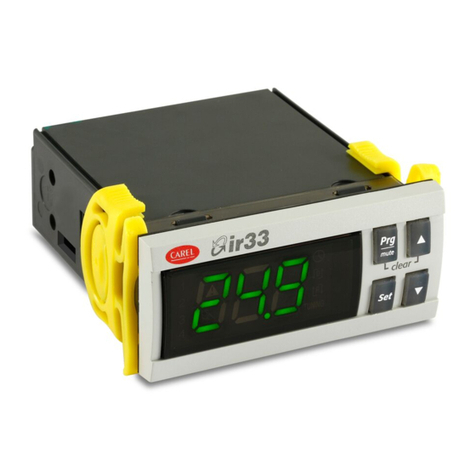
Carel
Carel ir33 Universale Replacement instructions
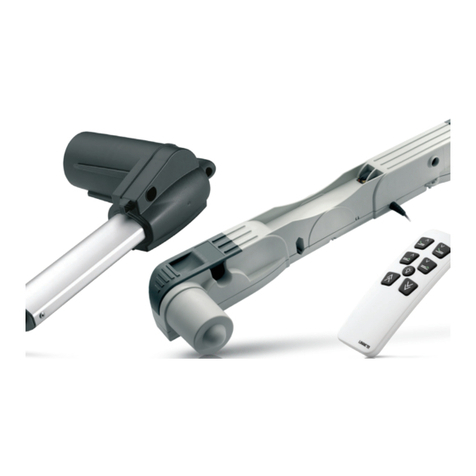
Linak
Linak TWINDRIVE TD1 280 user manual
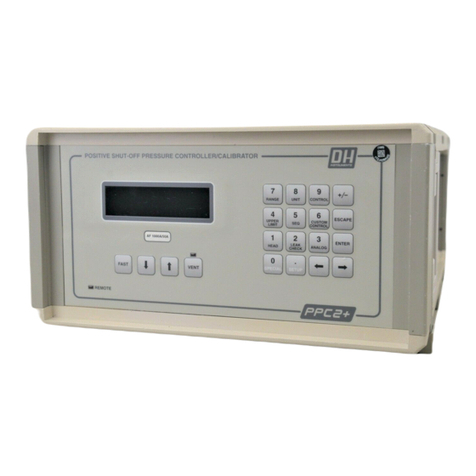
DH Instruments
DH Instruments PPC2 AF Operation and maintenance manual
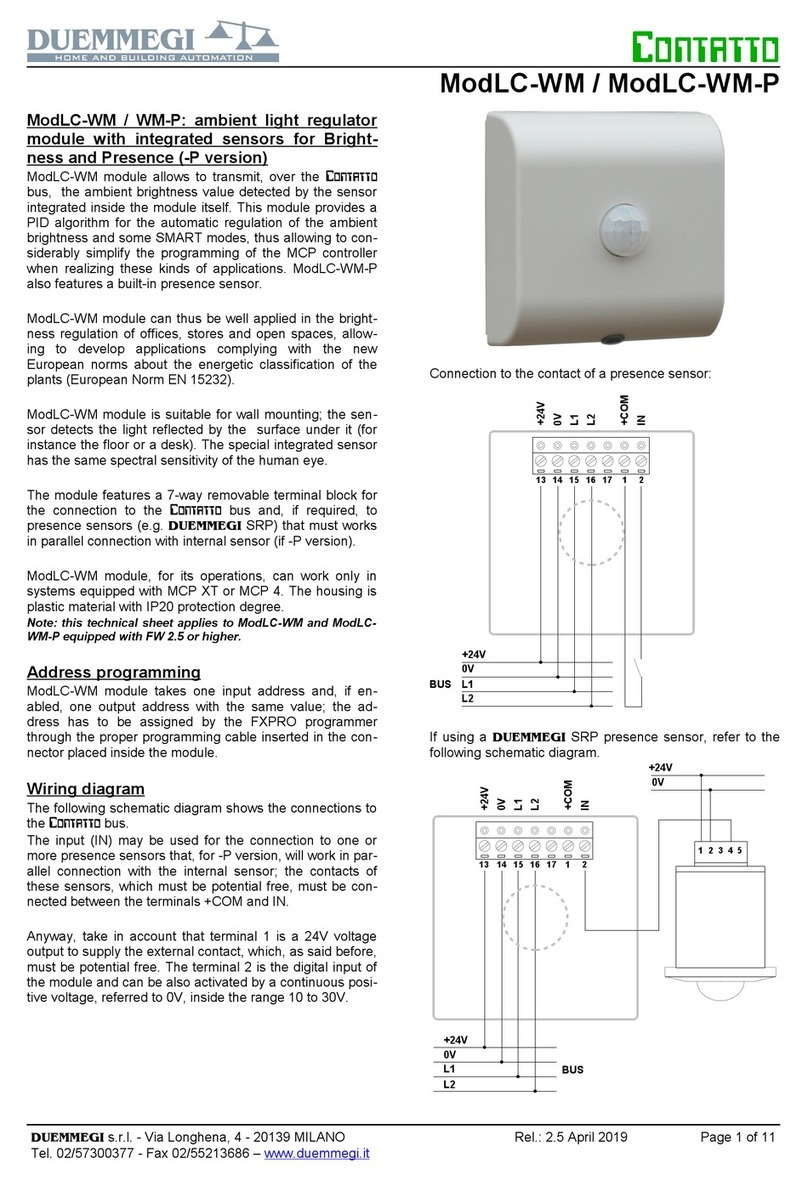
Duemmegi
Duemmegi Contatto ModLC-WM manual
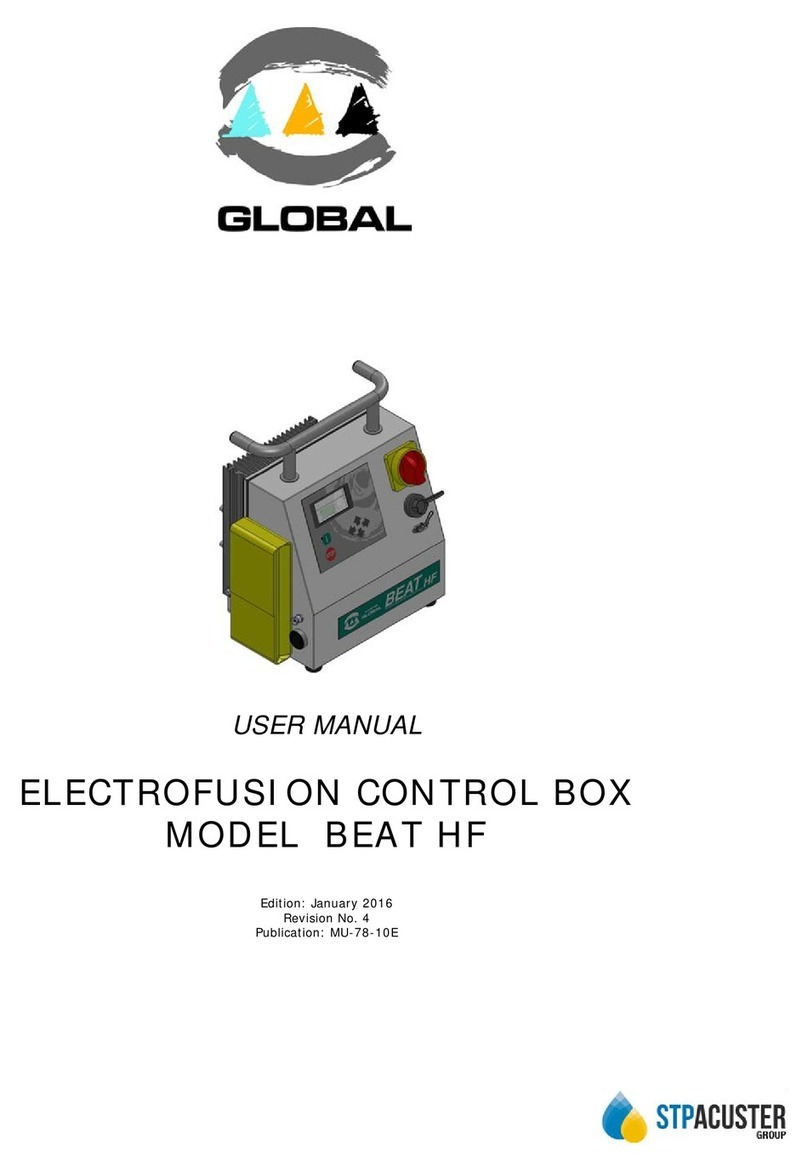
Acuster
Acuster BEAT HF user manual

DEEP SEA ELECTRONICS
DEEP SEA ELECTRONICS DSE5560 operating manual

